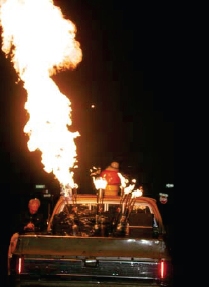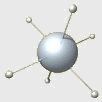 PL: First, as always, thanks for talking with IA. For those of the readers who aren't familiar with your work, could you give a brief synopsis and talk a little bit about the element of sound in your work? PL: First, as always, thanks for talking with IA. For those of the readers who aren't familiar with your work, could you give a brief synopsis and talk a little bit about the element of sound in your work?
ES: Sure. I've been a musician a little longer than I've had an interest in engineering (I think, since age 12?), and have been playing jazz, ska and rock professionally from age 15. I began my current project, LEMUR (LEMUR: The League of Electronic Musical Urban Robots, http://www.lemurbots.org/.) in 2000.
The intersection between art and technology began for me when I was studying computer engineering. As early as 1985 I found myself integrating computers and engineering with my love for music and media, and it has progressed more or less from there.
PL: In regards to new media, so much of the work and significant amounts of the theory seem to focus on the visual. Do you think that this is due to vision being a dominant sense and do you think that sound is often overlooked when it comes to art?
ES: Absolutely. Among the various calls for grants, residencies, and so on in our genre, there are a number for new media, film, video, but there is relatively little in regards to sound, really.
And sound is essential to experience, if you think about it. For example, watch a movie without the sound on. Although you might be able to get a basic idea of the film, so much information is missing that it's surprising how much sound contributes to the experience of anything. While this is true, LEMUR doesn't consider itself purely a 'sound' group; our approach is much more towards the whole range of sensoria, and we try to feel as comfortable in a performance environment as in a gallery. We're very interested in the creation of experiences within whatever context they happen to occur in.
PL: In your work with the Madagascar Institute, there was an intervention that incorporated a MIDI-driven Pyrophone. Could you talk a little about it? Was it the juxtaposition of historical forms, the sheer primal danger of creating such a thing, or something else that interested you?
ES: The work with the Madagascar Institute tends to be a little less philosophical, and a little more a confluence of a group of people's interests and skills. I've been interested in pyrophones for a while now and have done a bit of research on them. Secondly, the Madagascar Institute is really a bunch of pyromaniacs, and we were experimenting with propane cannons, triggered explosions, and the like, so the pyrophone was a logical fit. We took a propane source from a garden-variety barbeque pit propane tank, and interfaced a series of off-the-shelf sprinkler valves to a handheld MIDI sequencer, and went nuts. In the end, we had nine apertures creating a percussive (as opposed to a harmonic) pyrophone that based its sound on the explosion of the propane in the tube. By the way, that sort of ignition is really quite satisfying.
 PL: Was it dangerous? PL: Was it dangerous?
ES: It sounds good to say that it was terribly hazardous, but it wasn't as bad as you would think. Propane is pretty manageable, and it doesn't ignite where there isn't any oxygen. Of course, you don't want to put your face near any explosion, but it was amazingly well-behaved.
PL: On other occasions, we talked about the desire for permanence / archival in digital works. Jon Ippolito has formulated one solution in the Variable Media Initiative that sets general parameters for a given work. Many of the time-based works you have worked / collaborated on seem to have a very performative quality to them. Where do you think the line between performance and archive can be drawn in digital art?
ES: That's a tough question. What we're doing for the moment has a real element of performance, but foundations and curators need good archives and portfolios in order to be able to support your work.
Regardless of all that, I'm usually much more focused on the event coming off well. A lot of people collect things. LEMUR and Madagascar are people who concern themselves with the creation of experiences. So we and the people whom we've been around are collectors of those experiences, which -- if you look at it in a certain way -- are a lot more valuable than documentation. But as I said before, it's always good to have a nice portfolio.
Now, thinking about archiving, let's face it: all media deteriorate over time, it's just the rate that is the problem. The big challenge with digital media is that it changes so fast. The only way I can see for now to preserve important works is to, as I would say, 'pickle' them by making the computer integral to the piece. Emulation is fine, but the potential for not being able to keep the interfacing, sound, and all the elements of the piece together is great. The only way to really preserve a piece is to maintain all components, including the machine, OS, everything. The new Mac Mini might be a good thing in this respect. The computer is part of a new media piece. Keeping this in mind, the piece runs as long as the computer does, which hopefully is the case as long as we have a 100-volt power source with an Edison plug. Another thought would be to have a total mirror of a hard drive, so you could theoretically copy it to the new machine, and boot it up.
PL: Where do you think your work is heading with regard to your use of sound and performance, and do you think the latter may be indicative of a trend in the technological arts?
ES: Maybe more artists are now open to it, and more venues do seem to be interested in it. Technologies like sound software, soft synths, interconnective sound software are being used by more artists. 10 years ago, programs like Ableton Live and Reason just didn't exist; today the learning curve is less steep, and the whole genre is more accessible to people. In addition, alternative controllers are more popular here in New York, and that in itself is really exciting. So not only do you have a genre that is expanding through the technology inside the box, there are also interesting ways in which people are trying to interface to it musically.
|

